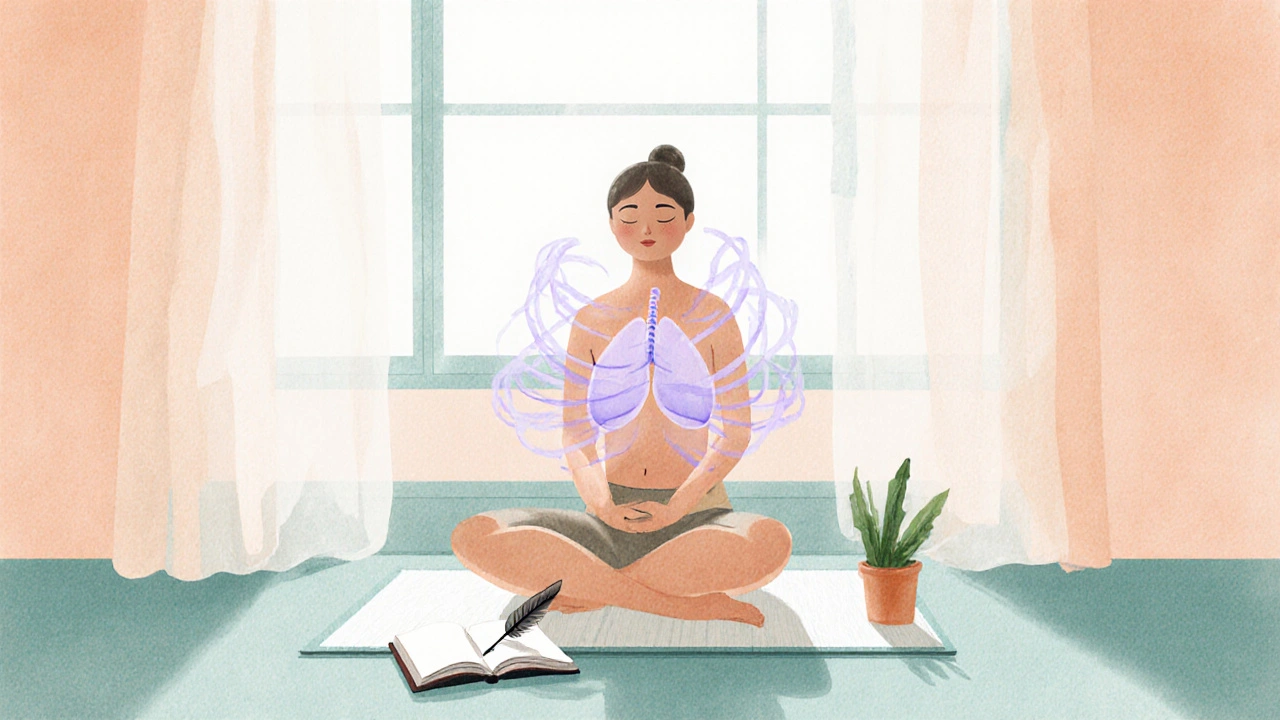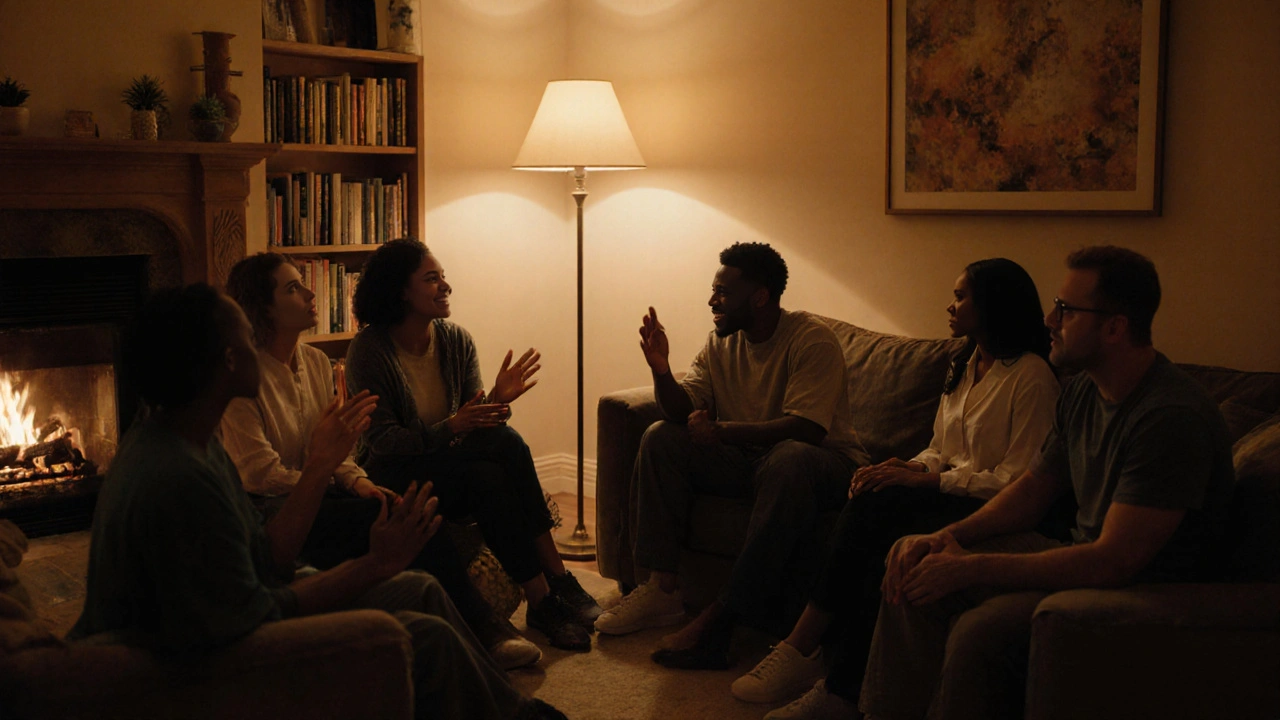Panic Attack Coping Strategy Selector
Your Personalized Coping Plan
Here are recommended strategies based on your inputs:
Find 5 things you can see, 4 you can touch, 3 you can hear, 2 you can smell, and 1 you can taste.
This helps bring your awareness back to the present moment and away from panic sensations.
Key Takeaways
- Identify personal panic triggers and early warning signs.
- Use breathing and grounding techniques to calm a panic attack within minutes.
- Combine Cognitive Behavioral Therapy (CBT) with lifestyle tweaks for lasting resilience.
- Consider medication only after a thorough assessment with a qualified professional.
- Build a support network that includes therapists, peers, and trusted friends.
Imagine feeling your heart race, thoughts spiraling, and a wave of dread crashing over you in the middle of a grocery aisle. That moment can feel endless, but the good news is you can train yourself to break that cycle. Below you’ll find a toolbox of proven tactics that help you regain control when panic strikes, plus a roadmap to keep anxiety in check over the long haul.
What Is Panic Disorder?
Panic Disorder is a chronic anxiety condition marked by recurrent, unexpected panic attacks and persistent fear of having another attack. It affects roughly 2-3% of adults worldwide, and it often starts in the late teens or early twenties. The disorder isn’t just about occasional nervousness; it’s a pattern that can disrupt work, relationships, and everyday activities.
How Does Panic Disorder Relate to General Anxiety?
Anxiety is a broad emotional response to perceived threats, ranging from mild unease to severe panic. While all panic attacks are a form of anxiety, not every anxiety episode culminates in a full‑blown panic attack. Understanding this distinction helps you choose the right coping method for each situation.
Recognizing a Panic Attack
A panic attack usually peaks within 10 minutes and includes symptoms like rapid heartbeat, shortness of breath, chest tightness, dizziness, and a sense of unreality. Knowing the "classic" symptom set allows you to label the experience as a panic attack rather than a heart problem, which alone can reduce fear.

Pinpointing Triggers and Early Warning Signals
Common triggers include caffeine, lack of sleep, stressful events, and even certain places that remind you of a past attack. Keep a simple log: note the time, location, what you ate, stress level, and any physical sensations. Over weeks, patterns emerge, and you can proactively adjust your routine.
Core Coping Strategies
Below are the most evidence‑based techniques you can practice alone or with a therapist.
1. Cognitive Behavioral Therapy (CBT)
Cognitive Behavioral Therapy is a structured, short‑term psychotherapy that helps you challenge and replace irrational thoughts that fuel panic. CBT teaches you to spot catastrophic thinking (“I’m going to die”) and replace it with realistic appraisals (“I’m experiencing anxiety, which is uncomfortable but not dangerous”).
2. Breathing Techniques
Breathing Techniques are simple, breath‑focused exercises that activate the parasympathetic nervous system and lower physiological arousal. The most popular is the 4‑7‑8 method: inhale for 4 seconds, hold for 7, exhale slowly for 8. Practice twice daily so the skill becomes automatic during an attack.
3. Grounding and Mindfulness
Mindfulness is the practice of staying present, observing thoughts without judgment, and gently returning focus to the now. Grounding exercises, like the "5‑4‑3‑2‑1" method (identify 5 things you see, 4 you feel, 3 you hear, 2 you smell, 1 you taste), shift attention away from internal panic cues.
4. Lifestyle Adjustments
- Limit caffeine and alcohol, both of which can heighten anxiety.
- Prioritize 7-9 hours of sleep; sleep deprivation spikes cortisol, the stress hormone.
- Engage in regular aerobic activity-running, brisk walking, or cycling-for at least 30 minutes most days.
- Practice progressive muscle relaxation before bed to lower nighttime tension.
5. Medication (When Needed)
Medication is a medical option that can reduce the frequency and intensity of panic attacks, typically prescribed after other strategies have been explored. Common classes include selective serotonin reuptake inhibitors (SSRIs) and benzodiazepines for short‑term crisis management. Always discuss risks and benefits with a psychiatrist.
Comparison of Main Coping Approaches
| Approach | How It Works | Typical Benefits | Possible Drawbacks |
|---|---|---|---|
| Cognitive Behavioral Therapy | Identifies and restructures distorted thoughts | Long‑term reduction of panic frequency; skill building | Requires weekly sessions, active participation |
| Medication (SSRIs, etc.) | Alters brain chemistry to dampen anxiety pathways | Fast symptom relief; useful for severe cases | Side effects, need for prescription, possible dependence |
| Breathing Techniques | Regulates oxygen‑carbon dioxide balance, calming the nervous system | Immediate relief; no cost; can be done anywhere | Effectiveness varies if not practiced regularly |
Building a Support System
Support Group is a community of people who share similar anxiety experiences, offering empathy, coping ideas, and accountability. Whether online or in‑person, regular attendance reduces isolation and provides real‑time feedback on what works.
In addition to groups, keep a list of trusted contacts-friends, family members, or a therapist-who you can call when an attack begins. A quick "I'm having a panic attack, can you stay on the line?" can dramatically lower fear of being alone.

Creating a Daily Maintenance Plan
Consistency is the secret sauce. Here’s a sample schedule you can tweak:
- Morning: 5‑minute breathing session, light stretching, and a brief gratitude journal.
- Midday: Check in with your trigger log; take a short walk if stress spikes.
- Evening: 10‑minute mindfulness practice, limit screen time an hour before bed, and prepare a calming bedtime routine.
Adjust timing based on work demands, but keep the core elements-breathing, mindfulness, and reflection-every day.
Quick Checklist for On‑The‑Spot Panic Management
- Notice the physical signs (racing heart, shortness of breath). \n
- Name the situation out loud: “I’m experiencing a panic attack.”
- Start the 4‑7‑8 breathing pattern.
- Engage a grounding exercise (5‑4‑3‑2‑1).
- Remind yourself that the feeling will pass in minutes.
- After the episode, record details in your trigger log.
When to Seek Professional Help
If attacks occur more than once a week, interfere with work, or you notice suicidal thoughts, reach out to a mental‑health professional immediately. Early intervention can prevent escalation and open doors to tailored therapy plans.
Frequently Asked Questions
Can panic disorder be cured?
While there’s no single “cure,” most people achieve long‑term control through a combination of CBT, lifestyle changes, and, when appropriate, medication. Consistent practice reduces attack frequency and severity.
How quickly do breathing exercises work?
If done correctly, you can feel a noticeable calm within 1-2 minutes. The key is regular practice so the technique becomes automatic during high‑stress moments.
Are there risks to taking anti‑anxiety medication?
All medications have potential side effects. SSRIs may cause nausea or sleep disturbances, while benzodiazepines can lead to dependence if used long‑term. A physician can weigh benefits against risks based on your health profile.
What if I can’t find a therapist who specializes in panic disorder?
Look for clinicians trained in CBT or anxiety disorders. Many offer tele‑therapy options, expanding access beyond your immediate area.
Is it safe to use relaxation apps during an attack?
Yes, as long as the app guides you through breathing or grounding without requiring visual focus that might be difficult during an attack. Audio‑only instructions often work best.
Armed with these tools, you’re not powerless against panic. Start small-pick one breathing exercise and practice it daily. Over weeks, layer in CBT worksheets, mindfulness moments, and supportive connections. The goal isn’t to eliminate anxiety entirely; it’s to give you a reliable set of strategies so you can live your life without panic dictating the script.
panic disorder coping is a journey, but each step you take builds a stronger, calmer you.







Harshal Sanghavi
October 5, 2025 AT 18:01Oh great, another checklist for panic attacks-just what the world needed, right? Seriously though, the 4‑7‑8 breathing is solid; give it a few minutes a day and you’ll thank yourself when the next wave hits.
Theunis Oliphant
October 15, 2025 AT 12:01One must not be deceived by the allure of quick‑fix fads; true mastery of anxiety resides in disciplined practice of cognitive restructuring. The article’s synthesis of CBT and physiological techniques reflects a commendable convergence of theory and praxis.
India Digerida Para Occidente
October 25, 2025 AT 06:01I appreciate the balanced view-melding breath work with grounding and cognitive shifts. When the chest tightens, naming the sensation aloud can shatter its power, and the 5‑4‑3‑2‑1 method grounds you in tangible reality.
Andrew Stevenson
November 4, 2025 AT 00:01From a psychophysiological standpoint, the autonomic nervous system modulation achieved via paced respiration aligns with vagal tone enhancement, which in turn attenuates amygdala hyper‑reactivity. Integrating this with exposure‑based CBT protocols yields a synergistic treatment algorithm.
Kate Taylor
November 13, 2025 AT 18:01You’re spot on about disciplined practice; coupling it with a personalized trigger log can transform vague anxiety into actionable data, making each session more data‑driven.
Hannah Mae
November 23, 2025 AT 12:01i think the grounding steps r easy 2 do but u gotta keep at it or it wont work.
Iván Cañas
December 3, 2025 AT 06:01Indeed, the neurobiological underpinnings you mention reinforce why a multi‑modal plan works across cultures; many patients benefit when we contextualize breathing within their daily routines.
Jen Basay
December 13, 2025 AT 00:01That data‑centric approach feels almost like a personal experiment, doesn’t it? I love tracking progress – it keeps motivation high 🙂.